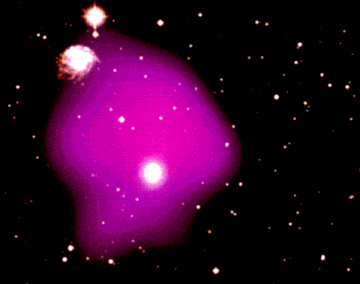When the Universe was young, it was nearly smooth and featureless. As it grew older and developed, it became organized. We know that our solar system is organized into planets (including the Earth!) orbiting around the Sun. On a scale much larger than the solar system (about 100 million times larger!), stars collect themselves into galaxies. Our Sun is an average star in an average galaxy called the Milky Way. The Milky Way contains about 100 billion stars. Yes, that's 100,000,000,000 stars! On still larger scales, individual galaxies are concentrated into groups, or what astronomers call clusters of galaxies.

An overlay of an optical image of a cluster of galaxies
with an x-ray image of hot gas lying within the cluster
The cluster includes the galaxies and any material which is in the space between the galaxies. The force, or glue, that holds the cluster together is gravity -- the mutual attraction of everything in the Universe for everything else. The space between galaxies in clusters is filled with a hot gas. In fact, the gas is so hot (tens of millions of degrees!) that it shines in X-rays instead of visible light. In the image above, the hot X-ray gas (shown in pink) lying between the galaxies is superimposed on an an optical picture of the cluster of galaxies. By studying the distribution and temperature of the hot gas we can measure how much it is being squeezed by the force of gravity from all the material in the cluster. This allows scientists to determine how much total material (matter) there is in that part of space.
Remarkably, it turns out there is five times more material in clusters of galaxies than we would expect from the galaxies and hot gas we can see. Most of the stuff in clusters of galaxies is invisible and, since these are the largest structures in the Universe held together by gravity, scientists then conclude that most of the matter in the entire Universe is invisible. This invisible stuff is called 'dark matter', a term initially coined by Fritz Zwicky who discovered evidence for missing mass in galaxies in the 1930s. There is currently much ongoing research by scientists attempting to discover exactly what this dark matter is, how much there is, and what effect it may have on the future of the Universe as a whole.
In simple words:-The normal matter is one which interacts with the other normal matter and hence we can see/feel thair presence or can measure/observe their presence. Whereas the dark matter is that type of matter/particles which do not interact with particles of the normal matter as such we can not observe them directly. But its presence can be felt by the force of gravity it exerts on other matter/ light.
[Read: Are We Alone In The Universe?]
[Read: What Are Black Holes?]

An overlay of an optical image of a cluster of galaxies
with an x-ray image of hot gas lying within the cluster
The cluster includes the galaxies and any material which is in the space between the galaxies. The force, or glue, that holds the cluster together is gravity -- the mutual attraction of everything in the Universe for everything else. The space between galaxies in clusters is filled with a hot gas. In fact, the gas is so hot (tens of millions of degrees!) that it shines in X-rays instead of visible light. In the image above, the hot X-ray gas (shown in pink) lying between the galaxies is superimposed on an an optical picture of the cluster of galaxies. By studying the distribution and temperature of the hot gas we can measure how much it is being squeezed by the force of gravity from all the material in the cluster. This allows scientists to determine how much total material (matter) there is in that part of space.
Remarkably, it turns out there is five times more material in clusters of galaxies than we would expect from the galaxies and hot gas we can see. Most of the stuff in clusters of galaxies is invisible and, since these are the largest structures in the Universe held together by gravity, scientists then conclude that most of the matter in the entire Universe is invisible. This invisible stuff is called 'dark matter', a term initially coined by Fritz Zwicky who discovered evidence for missing mass in galaxies in the 1930s. There is currently much ongoing research by scientists attempting to discover exactly what this dark matter is, how much there is, and what effect it may have on the future of the Universe as a whole.
In simple words:-The normal matter is one which interacts with the other normal matter and hence we can see/feel thair presence or can measure/observe their presence. Whereas the dark matter is that type of matter/particles which do not interact with particles of the normal matter as such we can not observe them directly. But its presence can be felt by the force of gravity it exerts on other matter/ light.
[Read: Are We Alone In The Universe?]
[Read: What Are Black Holes?]

"As it grew older and developed, it became organized". was in the first sentence. I think the universe got polluted with strange stuff like protons and neutrons. Atoms were formed and gasclouds were formed. From these clouds the stars were formed. Since this material is only 4 percent of the total universe this must be the trah that was formed during the lifespan of the universe. Maybe the dark matter and energy is the normal stuff and we (we all are made of stardust)are the abberation.
ReplyDelete